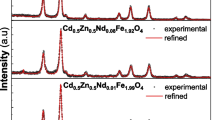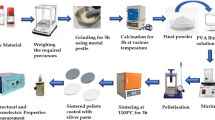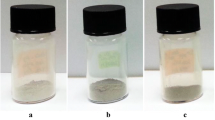Abstract
Structural and hyperfine properties of Er-doped SnO2 nanoparticles synthesized by a polymer precursor method are reported in this study. X-ray diffraction patterns of samples doped with erbium up to 10 mol % indicate the formation of the tetragonal rutile phase. The mean crystallite size shows a rapid decrease from ~12 nm for the undoped sample down to ~4 nm for the 10 mol % Er-doped sample. Structural changes as a function of the Er content, i.e., changes in the lattice constants, Sn–O bond distances and bond angles, strongly suggest the substitutional solution of Er3+ ions and the onset of oxygen vacancies throughout the SnO2 lattice. No dipolar-magnetic interaction is determined from the Mössbauer spectra which are well resolved by fitting with a distribution of electric-quadrupole doublets. Changes observed in the quadrupole splitting as a function of the Er content have been associated to the local strain induced by the cationic size mismatch and oxygen vacancies. This local strain affects the lattice contribution of the electric field gradient. The linear increase of the isomer shift is assigned to the enhancement of the oxygen vacancies as the Er content is increased. It is found that the oxygen vacancies provide with conduction electrons to the Er-doped SnO2 nanoparticulated system, therefore modifying its electronic properties.









Similar content being viewed by others
References
Aragón FH, Coaquira JAH, Hidalgo P, Brito SLM, Gouvêa D, Castro RHR (2010) Experimental study of the structural, microscopy and magnetic properties of Ni-doped SnO2 nanoparticles. J Non Cryst Solids 356:2960–2964
Aragón FH, Cohen R, Coaquira JAH, Barros GV, Hidalgo P, Nagamine LCCM, Gouvêa D (2011) Effects of particle size on the structural and hyperfine properties of tin dioxide nanoparticles. Hyper Inter 202:73–79
Barone G, Mastalerz R, Reiher M, Lindh R (2008) Nuclear quadrupole moment of 119Sn. J Phys Chem A 112:1666–1672
Baur WH, Khan AA (1971) Rutile-type compounds. IV. SiO2, GeO2 and a comparison with other rutile-type structures. Acta Cryst B 27:2133–2139
Brand RA (1990) User’s guide of the Normos Mössbauer fitting program. Wissenschaftlich Elektronik GmbH, Duisburg
Castro RHR, Hidalgo P, Coaquira JAH, Bettini J, Zanchet D, Gouvêa D (2005) Surface segregation in SnO2–Fe2O3 nanopowders and effects in Mössbauer spectroscopy. Eur J Inorg Chem 11:2134–2138
Chang ES, Graham EK (1975) The elastic constants of cassiterite as a function of pressure and temperature. J Geophys Res 80:2595–2599
Cosentino IC, Muccillo R (2001) Lattice parameters of thoria–yttria solid solutions. Mater Lett 48:253–257
Freeman CM, Catlow CRA (1990) A computer modeling study of defect and dopant states in SnO2. J Solid State Chem 85:65–75
Gonser U (1975) Mössbauer spectroscopy. Springer, Berlin
Hidalgo P, Castro RHR, Coelho ACV, Gouvêa D (2005) Surface segregation and consequent SO2 sensor response in SnO2–NiO. Chem Mater 17:4149–4153
Hong SJ, Virkar AV (1995) Lattice parameters and densities of rare earth oxide doped ceria electrolytes. J Am Ceram Soc 78:433–439
Huang CH, Knop O, Othen DA, Woodhams FWD, Howie RA (1975) Pyrophosphates of tetravalent elements and a Mössbauer study of SnP2O7. Can J Chem 53:79–91
Kong J, Zhu H, Li R, Luo W, Chen X (2009) Carrier-mediated 1.55 μm photoluminescence from single Er3+ center in SnO2 nanocrystals. Optics Lett 34:1873–1875
Kung HH (1991) Transition metal oxides: surface chemistry and catalysis, vol 45. Elsevier Science Publishing Company Inc., New York
Matsuoka T, Tohda T, Nitta T (1983) The low-energy-electron (LEE) excitation of SnO2: Eu powder phosphor; fundamental characteristics. J Electrochem Soc 130:417–423
Miglierini M, Skorvánek I (1991) Mössbauer and AC susceptibility study of structurally modified Fe–Ni–Cr–Mo–Si–B-type metallic glasses. J Phys Condens Matter 3:2721–2727
Otobe H, Nakamura A (1999) Lattice parameters and defect structure of the fluorite- and C-type oxide solid solutions between MO2 and M2O3. Proceedings of the sixth international symposium on solid oxide fuel cells. The Electrochemical Society Inc., New Jersey
Paiva-Santos CO, Cavalheiro AA, Cilense MA, Varela JA, Silva MT, Mascarenhas YP (2001) An XRD study of the structure and microstructure of the laboratory synthesized crystals of MgNb2O6 (MN) and PbMg1/3Nb2/3O3 (PMN). Adv X-Ray Anal 44:38–43
Pereira GJ, Castro RHR, Hidalgo P, Gouvêa D (2002) Surface segregation of additives on SnO2 based powders and their relationship with macroscopic properties. Appl Surf Sci 195:277–283
Ravaro LP, Morais EA, Scalvi LVA, Li MS (2007) Visible emission from Er-doped SnO2 thin films deposited by sol-gel. Cerâmica 53:187–191
Robertson J (1979) Electronic structure of SnO2, GeO2, PbO2, TeO2 and MgF2. J Phys C 12:4767–4776
Sambasivam S, Kim SB, Jeong JH, Choi BC, Lim KT, Kim SS, Song TK (2010) Effect of Er3+ doping in SnO2 semiconductor nanoparticles synthesized by solgel technique. Curr Appl Phys 10:1383–1386
Sen KD, Narasimhan PT (1977) Sternheimer antishielding factors for core electrons in metals: comparison with free-ion results. Phys Rev A 16:1786–1788
Sensato FR, Custodio R, Longo E, Beltrán A, Andrés J (2003) Electronic and structural properties of Sn x Ti1−x O2 solid solutions: a periodic DFT study. Catal Today 85:145–152
Stjerna B, Granqvist CG, Seidel A, Häggströn L (1990) Characterization of rf-sputtered SnOx thin films by electron microscopy, Hall-effect measurement, and Mössbauer spectrometry. J Appl Phys 68:6241–6245
Stöckler HA, Sano H, Herber RH (1966) Mössbauer-effect studies of weak nuclear quadrupole interactions in 119Sn. J Chem Phys 45:1182–1189
Acknowledgments
The authors thank the Brazilian agencies CAPES, CNPq, FAPESP and FAPDF for the financial support. The authors are grateful to Dr. E. M. Guimarães for carrying out X-ray diffraction measurements.
Author information
Authors and Affiliations
Corresponding author
Rights and permissions
About this article
Cite this article
Aragón, F.H., Coaquira, J.A.H., Hidalgo, P. et al. Experimental evidences of substitutional solution of Er dopant in Er-doped SnO2 nanoparticles. J Nanopart Res 15, 1343 (2013). https://doi.org/10.1007/s11051-012-1343-1
Received:
Accepted:
Published:
DOI: https://doi.org/10.1007/s11051-012-1343-1




